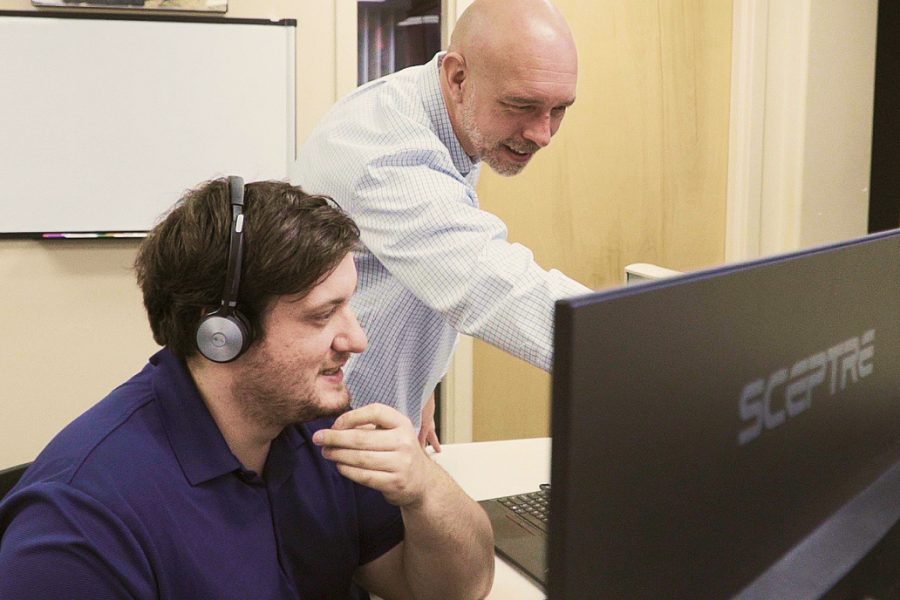
17/09/23
3 min

Businesses are constantly searching for innovative ways to improve efficiency, productivity, and employee satisfaction. One of the most significant developments in recent years has been the shift from traditional handsets to headsets in the workplace. This transition represents a fundamental change in how we communicate and collaborate, offering a wide range of benefits that go beyond mere convenience.
With a headset in hand (or rather, on your head), the traditional handset becomes a redundant artifact of the past. These compact, audio-enhancing devices have evolved beyond their initial use in call centers and customer service jobs, and now, they serve a broad range of functions in different industries. Embracing headsets in your work environment not only propels your communication capabilities into the future but also transforms the way you work, collaborate, and engage with technology. It’s a paradigm shift that brings unprecedented flexibility, efficiency, and comfort to the forefront of your professional experience.
In this blog post, we will explore the value of moving from handsets to headsets. We will discuss the numerous advantages that headsets bring to the table, such as enhanced communication, increased mobility, improved focus, and overall workplace satisfaction. The era of the headset is here, and it’s reshaping the way we connect and communicate in the workplace. Let’s dive into this exciting transformation and see how it is shaping the future of work.
Enhanced Communication
Effective communication is the lifeblood of any successful business. Traditional handsets, while functional, have their limitations when it comes to facilitating clear and efficient communication. Headsets, on the other hand, provide a superior communication experience in various ways:
- Noise Cancellation: Headsets often come equipped with advanced noise-canceling technology that minimizes background noise, ensuring that both parties can hear each other clearly. This is especially beneficial in open office environments where ambient noise can be distracting.
Hands-Free Operation: With headsets, employees can keep their hands free to multitask while on a call. This is invaluable for tasks that require data entry, note-taking, or collaboration on a computer while talking. - Mobility: Many headsets are wireless, allowing employees to move around the office or even work from remote locations while maintaining a crystal-clear connection. This mobility improves accessibility and responsiveness.
- Unified Communications: Headsets can seamlessly integrate with various communication platforms, such as VoIP, video conferencing, and collaboration tools. This enables employees to switch between communication methods effortlessly, streamlining their workflow.
- Customization: Headsets often come with adjustable features, such as microphone boom positioning and headband size, allowing employees to customize the fit and feel for maximum comfort during prolonged use.
Increased Mobility
The modern work environment is no longer confined to a static desk or cubicle. Employees need the flexibility to move around and collaborate with colleagues in different areas of the office or work remotely. Headsets play a pivotal role in enabling this mobility:
- Flexibility: Wireless headsets allow employees to move freely without being secured to a specific location. This mobility fosters collaboration and creativity, as employees can easily join impromptu meetings or group sessions.
- Remote Work: As remote work becomes increasingly prevalent, headsets empower employees to work from home, coffee shops, or co-working spaces while maintaining the same level of connectivity as if they were in the office. This flexibility contributes to a healthier work-life balance.
- On-the-Go Productivity: Headsets are not limited to the office or home. They can be used while traveling, making it possible for employees to stay connected and productive on business trips or during daily commutes.
Improved Focus
Distractions in the workplace can significantly hamper productivity. Traditional handsets, with their need for a physical connection, can make it challenging to create a focused work environment. Headsets address this issue by helping employees maintain concentration and block out distractions:
- Personal Space: Wearing a headset signals to colleagues that you are engaged in a call or focused on a task, reducing the likelihood of interruptions. This visual cue helps establish personal space in open office layouts.
- Ergonomic Design: Headsets are designed with comfort in mind, allowing employees to wear them for extended periods without discomfort. This ergonomic advantage contributes to better focus and reduced fatigue.
- Immersive Audio: High-quality audio delivered through headsets helps employees engage more deeply in their work. Whether they’re on a critical call, participating in a virtual meeting, or listening to informative podcasts or training materials, headsets provide a superior audio experience that enables users to grasp information more effectively. This heightened auditory experience contributes to improved retention and comprehension, ultimately boosting their focus.
Overall Workplace Satisfaction
A satisfied workforce is a productive workforce. The transition from handsets to headsets can have a positive impact on overall workplace satisfaction:
- Employee Well-Being: Headsets offer a more comfortable and flexible communication experience, which can improve employee well-being. Reduced stress from noisy environments and the ability to work remotely contribute to higher job satisfaction.
- Enhanced Collaboration: The mobility and noise-canceling capabilities of headsets facilitate seamless collaboration among team members. Employees feel more connected to their colleagues and are more likely to enjoy their work when collaboration is effortless.
- Technological Advancement: Investing in modern communication tools like headsets shows employees that their employer values innovation and strives to provide them with the latest and best technology. This can boost morale and job satisfaction.
- Cost Savings: While there is an initial investment in headsets, the long-term cost savings from reduced absenteeism (due to remote work options) and increased productivity often outweigh the expenses.
A Sustainable Approach
The transition from handsets to headsets aligns with the global trend toward sustainability in the workplace:
- Reduced Carbon Footprint: By enabling remote work, headsets can help reduce the need for daily commutes, which, in turn, lowers carbon emissions. Fewer office facilities are needed, further decreasing the environmental impact.
- Energy Efficiency: Modern headsets are designed to be energy-efficient, using less power compared to traditional phone systems. This not only reduces operational costs but also contributes to a greener office.
- Paperless Communication: Headsets are often used in conjunction with digital communication tools, reducing the reliance on paper and promoting a paperless office culture.
The transition from handsets to headsets in the modern work environment represents a significant shift in the way we communicate and collaborate. This transition offers a multitude of benefits, including enhanced communication, increased mobility, improved focus, and overall workplace satisfaction. It aligns with sustainability goals, making it a win-win for both businesses and the environment.
As businesses continue to adapt to changing work dynamics and evolving technologies, the adoption of headsets is becoming more than just a trend; it’s a necessity. Embracing this shift can empower employees, boost productivity, and position your organization for success in the digital age. The future of work is wireless, mobile, and headset-enabled, and those who embrace it will thrive.
Related Blogs









